Statistics: Stone Operators
On This Page
Introduction
The following maps, graphs, and tables present data for Stone Mne Operators. The information is organized by Mines, Employees, Fatalities, and Injuries. The Mines section contains information on the number and location of the mining operations. The Employees section details the number of employees and the number of employee hours. The Fatalities section describes the number and rate of fatalities, the number and rate by work locations, and the number of fatalities by accident class. The Injuries section presents the number and rate of nonfatal lost-time injuries, the number and rate by work locations, and the number of injuries by accident class. Data source: Mine Safety and Health Administration (MSHA). See Statistical Methodology for further details. Additional Mining Facts for each commodity are available from 2000 through 2015.
Mines
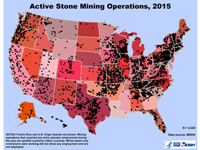 Active Stone Mining Operations, 2015: Map of the United States displaying the locations of active stone mining operations spotted randomly within counties in 2015. Active mines are mining operations that reported mine operator employment during the year. There were 4,303 stone mines. Mines at which only contractors were working did not show any employment and are not displayed.
Active Stone Mining Operations, 2015: Map of the United States displaying the locations of active stone mining operations spotted randomly within counties in 2015. Active mines are mining operations that reported mine operator employment during the year. There were 4,303 stone mines. Mines at which only contractors were working did not show any employment and are not displayed.
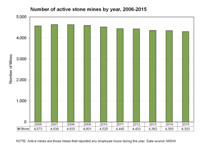 Number of Active Stone Mines by Year, 2006-2015: Graph displaying the number of active mines for a 10-year period from 2006 through 2015. Active mines are those mines that reported any mine operator employee hours during the year. Stone mines have remained relatively level over the period with 4,303 mines in 2015.
Number of Active Stone Mines by Year, 2006-2015: Graph displaying the number of active mines for a 10-year period from 2006 through 2015. Active mines are those mines that reported any mine operator employee hours during the year. Stone mines have remained relatively level over the period with 4,303 mines in 2015.
 Active Mining Operations, 2015 (Underground Stone): Map of the United States displaying the locations of active underground stone mining operations mining spotted randomly within counties in 2015. Active mines are mining operations that reported mine operator employment during the year. There were 116 underground stone mines reported in 2015. Mines at which only contractors were working did not show any employment and are not displayed.
Active Mining Operations, 2015 (Underground Stone): Map of the United States displaying the locations of active underground stone mining operations mining spotted randomly within counties in 2015. Active mines are mining operations that reported mine operator employment during the year. There were 116 underground stone mines reported in 2015. Mines at which only contractors were working did not show any employment and are not displayed.
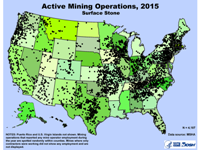 Active Mining Operations, 2015 (Surface Stone): Map of the United States displaying the locations of active surface stone mining operations spotted randomly within counties in 2015. Active mines are mining operations that reported mine operator employment during the year. There were 4,187 surface stone mines. Mines at which only contractors were working did not show any employment and are not displayed.
Active Mining Operations, 2015 (Surface Stone): Map of the United States displaying the locations of active surface stone mining operations spotted randomly within counties in 2015. Active mines are mining operations that reported mine operator employment during the year. There were 4,187 surface stone mines. Mines at which only contractors were working did not show any employment and are not displayed.
Employees
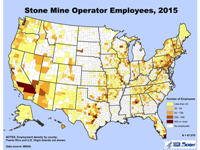 Stone Mine Operator Employees, 2015: Map of the United States displaying employment density by county of the 67,070 stone mine operator employees in 2015. A graduated color ramp is used to symbolize densities of less than 25 employees, 25 to 49 employees, 50 to 199 employees, 200 to 499 employees, and 500 or more employees.
Stone Mine Operator Employees, 2015: Map of the United States displaying employment density by county of the 67,070 stone mine operator employees in 2015. A graduated color ramp is used to symbolize densities of less than 25 employees, 25 to 49 employees, 50 to 199 employees, 200 to 499 employees, and 500 or more employees.
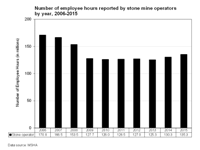 Number of Employee Hours Reported by Stone Mine Operators, 2006-2015: Graph displaying the number of stone mine operator employee hours reported from 2006 through 2015. The employee hours varied over the period from 170.8 million hours in 2006 to 135.3 million hours in 2015. The year with the least number of employee hours was 2013 when 125.3 million hours were reported.
Number of Employee Hours Reported by Stone Mine Operators, 2006-2015: Graph displaying the number of stone mine operator employee hours reported from 2006 through 2015. The employee hours varied over the period from 170.8 million hours in 2006 to 135.3 million hours in 2015. The year with the least number of employee hours was 2013 when 125.3 million hours were reported.
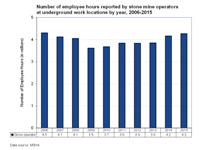 Number of Employee Hours Reported by Stone Mine Operators at Underground Work Locations by Year, 2006-2015: Graph displaying the number of underground stone mine operator employee hours reported from 2006 through 2015. The employee hours varied over the period from a low of 3.6 million hours in 2009 to a high of 4.3 million hours reported in both 2006 and 2015.
Number of Employee Hours Reported by Stone Mine Operators at Underground Work Locations by Year, 2006-2015: Graph displaying the number of underground stone mine operator employee hours reported from 2006 through 2015. The employee hours varied over the period from a low of 3.6 million hours in 2009 to a high of 4.3 million hours reported in both 2006 and 2015.
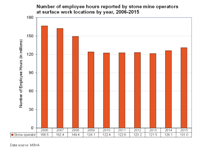 Number of Employee Hours Reported by Stone Mine Operators at Surface Work Locations by Year, 2006-2015: Graph displaying the number of surface stone mine operator employee hours reported from 2006 through 2015. The employee hours varied over the period with a high of 166.5 million hours reported in 2006. In 2009, the hours declined to 124.1 million hours and remained steady over the period with 131.0 million hours reported in 2015.
Number of Employee Hours Reported by Stone Mine Operators at Surface Work Locations by Year, 2006-2015: Graph displaying the number of surface stone mine operator employee hours reported from 2006 through 2015. The employee hours varied over the period with a high of 166.5 million hours reported in 2006. In 2009, the hours declined to 124.1 million hours and remained steady over the period with 131.0 million hours reported in 2015.
Fatalities
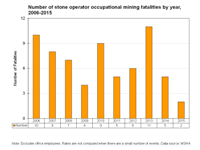 Number of Stone Operator Occupational Mining Fatalities by Year, 2006-2015: Graph displaying the number of occupational mining fatalities, excluding office employees, from 2006 through 2015. Rates are not computed when there are a small number of events. Fatalities varied over the period with the highest number of 11 occurring in 2013. The year with the least number of fatalities was 2015 when 2 occurred.
Number of Stone Operator Occupational Mining Fatalities by Year, 2006-2015: Graph displaying the number of occupational mining fatalities, excluding office employees, from 2006 through 2015. Rates are not computed when there are a small number of events. Fatalities varied over the period with the highest number of 11 occurring in 2013. The year with the least number of fatalities was 2015 when 2 occurred.
Injuries
 Nonfatal Lost-time Injuries, 2015 (Stone Mine Operators and Independent Contractors): Map of the United States displaying nonfatal lost-time injury density by county for 1,273 stone mine operator and contractor injuries during 2015. Office workers are excluded. A graduated color ramp is used to symbolize densities of zero injuries, 1 to 9, 10 to 29, 30 to 49, and 50 or more injuries.
Nonfatal Lost-time Injuries, 2015 (Stone Mine Operators and Independent Contractors): Map of the United States displaying nonfatal lost-time injury density by county for 1,273 stone mine operator and contractor injuries during 2015. Office workers are excluded. A graduated color ramp is used to symbolize densities of zero injuries, 1 to 9, 10 to 29, 30 to 49, and 50 or more injuries.
 Number and Rate of Stone Mining Operator Nonfatal Lost-time Injuries at Underground Work Locations by Year, 2006-2015: Graph displays the number and rate of stone mining operator nonfatal lost-time injuries at underground work locations, excluding office employees, from 2006 through 2015. Full-time equivalent (FTE) employees are based on 2,000 employee hours worked per year. The rates and numbers have varied over the period. The highest rate was 2.2 nonfatal lost-time injuries per 100 FTEs and occurred in both 2010 and 2012. The lowest rate was 1.6 per 100 FTEs in 2008. The highest number of injuries occurred in 2014 with 44 reported. The year with the lowest number of nonfatal lost-time injuries was 2008 when 33 were reported.
Number and Rate of Stone Mining Operator Nonfatal Lost-time Injuries at Underground Work Locations by Year, 2006-2015: Graph displays the number and rate of stone mining operator nonfatal lost-time injuries at underground work locations, excluding office employees, from 2006 through 2015. Full-time equivalent (FTE) employees are based on 2,000 employee hours worked per year. The rates and numbers have varied over the period. The highest rate was 2.2 nonfatal lost-time injuries per 100 FTEs and occurred in both 2010 and 2012. The lowest rate was 1.6 per 100 FTEs in 2008. The highest number of injuries occurred in 2014 with 44 reported. The year with the lowest number of nonfatal lost-time injuries was 2008 when 33 were reported.
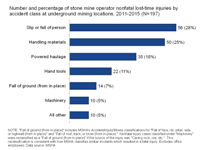 Number and Percentage of Stone Mine Operator Nonfatal Lost-time Injuries by Accident Class at Underground Mining Locations, 2011-2015: Graph displays the distribution of nonfatal lost-time injuries by accident class for stone operators at underground mining locations for the period from 2011 through 2015. There were a total of 197 lost-time injuries, excluding office employees. "Slip or fall of person" had 28.0%, "Handling materials" had 25.0%, "Powered haulage" had 18.0%, "Hand tools" had 11.0%, and "Fall of ground (from in place)", which includes MSHA’s Accident/Injury/Illness Classifications for "Fall of face, rib, pillar, side, or highwall from in place" and "Fall of roof, back, or brow from in place," had 7.0% of the nonfatal lost-time injuries. Nonfatal injury cases classified under machinery were reclassified as a fall of ground (from in place) if the source of the injury was caving rock, ore, etc. This reclassification is consistent with how MSHA classifies similar incidents which resulted in a fatal injury. Both "Machinery" and the "All other" category had 5.0% of the nonfatal lost-time injuries during the period. Note that the sum of percentages may not equal 100 due to independent rounding.
Number and Percentage of Stone Mine Operator Nonfatal Lost-time Injuries by Accident Class at Underground Mining Locations, 2011-2015: Graph displays the distribution of nonfatal lost-time injuries by accident class for stone operators at underground mining locations for the period from 2011 through 2015. There were a total of 197 lost-time injuries, excluding office employees. "Slip or fall of person" had 28.0%, "Handling materials" had 25.0%, "Powered haulage" had 18.0%, "Hand tools" had 11.0%, and "Fall of ground (from in place)", which includes MSHA’s Accident/Injury/Illness Classifications for "Fall of face, rib, pillar, side, or highwall from in place" and "Fall of roof, back, or brow from in place," had 7.0% of the nonfatal lost-time injuries. Nonfatal injury cases classified under machinery were reclassified as a fall of ground (from in place) if the source of the injury was caving rock, ore, etc. This reclassification is consistent with how MSHA classifies similar incidents which resulted in a fatal injury. Both "Machinery" and the "All other" category had 5.0% of the nonfatal lost-time injuries during the period. Note that the sum of percentages may not equal 100 due to independent rounding.
 Number and Rate of Stone Mining Operator Nonfatal Lost-time Injuries at Surface Work Locations by Year, 2006-2015: Graph displaying the number and rate of stone mining operator nonfatal lost-time injuries at surface work locations, excluding office employees, from 2006 through 2015. Full-time equivalent (FTE) employees are based on 2,000 employee hours worked per year. The number and rate of nonfatal lost-time injuries has decreased over the period from 2,038 injuries with a rate of 2.8 in 2006 to 1,075 injuries with a rate of 1.9 per 100 FTEs in 2015.
Number and Rate of Stone Mining Operator Nonfatal Lost-time Injuries at Surface Work Locations by Year, 2006-2015: Graph displaying the number and rate of stone mining operator nonfatal lost-time injuries at surface work locations, excluding office employees, from 2006 through 2015. Full-time equivalent (FTE) employees are based on 2,000 employee hours worked per year. The number and rate of nonfatal lost-time injuries has decreased over the period from 2,038 injuries with a rate of 2.8 in 2006 to 1,075 injuries with a rate of 1.9 per 100 FTEs in 2015.
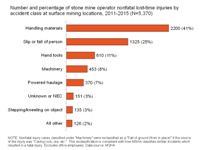 Number and Percentage of Stone Mine Operator Nonfatal Lost-time Injuries by Accident Class at Surface Mining Locations, 2011-2015: Graph displaying the distribution of nonfatal lost-time injuries by accident class for stone operators at surface mining locations for the period from 2011 through 2015. There were a total of 5,370 lost-time injuries, excluding office employees. "Handling materials" had 41.0%, "Slip or fall of person" had 25.0%, "Hand tools" had 11.0% and "Machinery" had 8.0% of nonfatal lost-time injuries. Note that nonfatal injury cases classified under machinery were reclassified as a fall of ground (from in place) if the source of the injury was caving rock, ore, etc. This reclassification is consistent with how MSHA classifies similar incidents which resulted in a fatal injury. "Powered haulage" had 7.0%. Both "Unknown or NEC" and "Stepping/kneeling on object" had 3.0%, and the "All other" category had 2.0% of the nonfatal lost-time injuries during the 5-year period. Note that the sum of percentages may not equal 100 due to independent rounding.
Number and Percentage of Stone Mine Operator Nonfatal Lost-time Injuries by Accident Class at Surface Mining Locations, 2011-2015: Graph displaying the distribution of nonfatal lost-time injuries by accident class for stone operators at surface mining locations for the period from 2011 through 2015. There were a total of 5,370 lost-time injuries, excluding office employees. "Handling materials" had 41.0%, "Slip or fall of person" had 25.0%, "Hand tools" had 11.0% and "Machinery" had 8.0% of nonfatal lost-time injuries. Note that nonfatal injury cases classified under machinery were reclassified as a fall of ground (from in place) if the source of the injury was caving rock, ore, etc. This reclassification is consistent with how MSHA classifies similar incidents which resulted in a fatal injury. "Powered haulage" had 7.0%. Both "Unknown or NEC" and "Stepping/kneeling on object" had 3.0%, and the "All other" category had 2.0% of the nonfatal lost-time injuries during the 5-year period. Note that the sum of percentages may not equal 100 due to independent rounding.
See Also
- A Computer Software Program that Estimates Air Quantity Requirements in Large Opening Stone Mines
- The Effects of Water Emulsified Fuel on Diesel Particulate Matter Concentrations in Underground Mines
- Effects of Weak Bands on Pillar Stability in Stone Mines: Field Observations and Numerical Model Assessment
- Elastic and Shear Moduli of Coal Measure Rocks Derived from Basic Well Logs Using Fractal Statistics and Radial Basis Functions
- Electromagnetic Noise in Itmann Mine
- Mining Fact Sheets
- Mining Facts - 2015
- Pillar and Roof Span Design Guidelines for Underground Stone Mines
- Pillar Stability Issues Based on a Survey of Pillar Performance in Underground Limestone Mines
- Pillar Strength and Design Methodology for Stone Mines
- Statistical Methodology
- Statistics: Sand & Gravel Operators
- Stone and Sand & Gravel Industry Sector
- Technology News 481 - Update: Roof Monitoring Safety System for Underground Stone Mines
- Page last reviewed: 5/22/2017
- Page last updated: 5/22/2017
- Content source: National Institute for Occupational Safety and Health, Mining Program


 ShareCompartir
ShareCompartir